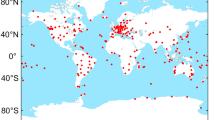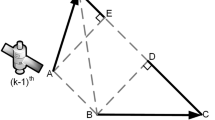Abstract
Based on the signal model of fixed-receiver bistatic SAR, this paper analyzes the characteristics of azimuth-variant, which includes variation of range migration curve and variation of Doppler rate caused by different azimuth position of targets. Then, an extended nonlinear chirp scaling (NLCS) algorithm is proposed, with its flowchart and phase compensation functions being provided. Simulation results show that the algorithm is available for the characteristics of azimuth-variant of fixed-receiver bistatic SAR, and good focused radar images could be acquired.
Similar content being viewed by others
References
Qiu X L, Hu D H, Ding C B. An improved NLCS algorithm with capability analysis for one-stationary BiSAR. IEEE Trans Geosci Remote Sens, 2008, 46: 3179–3186
Geng X P, Yan H H, Wang Y F. A two-dimensional spectrum model for general bistatic SAR. IEEE Trans Geosci Remote Sens, 2008, 46: 2216–2223
Krieger G, Moreira A. Spaceborne bi- and multistatic SAR: potentials and challenges. IEE Proc Radar Sonar Navig, 2006, 153: 184–198
Walterscheid I, Ender J, Brenner A R, et al. Bistatic SAR processing and experiments. IEEE Trans Geosci Remote Sens, 2006, 44: 2710–2717
Adilb Y N, Fawwaz T U. Bistatic SAR imaging: a novel approach using stationary receiver. In: IEEE International Geosci and Remote Sens Symposium. Barcelona: IEEE, 2007. 125–128
Jesus S M, Pau P, Jordi J M. Bistatic fixed-receiver parasitic SAR processor based on the back-propagation algorithm. In: IEEE International Geosci and Remote Sens Symposium. Seoul: IEEE, 2005. 1056–1059
Jesus S M, Jordi J M, Albert A, et al. First ENVISAT and ERS-2 parasitic bistatic receiver SAR images processed with the subaperture range-doppler algorithm. In: IEEE International Geosci and Remote Sens Symposium. Denver: IEEE, 2006. 1840–1843
Yu D, Munson D C J. A fast back-projection algorithm for bistatic SAR imaging. In: IEEE International Conference on Image Processing. New York: IEEE, 2002. 449–452
Wong F H, Tat S Y. New application of Nonlinear chirp scaling in SAR data processing. IEEE Trans Geosci Remote Sens, 2001, 39: 946–953
Neo Y L, Wong F H, Cumming I G. A two-dimensional spectrum for bistatic SAR processing using series reversion. IEEE Lett Geosci Remote Sens, 2007, 4: 93–96
Zhang C B. Synthetic Aperture Radar—Theory, System Analysis and Applications (in Chinese). Beijing: Science Press, 1989. 163–178
Cumming I G, Wong F H. Digital processing of synthetic aperture radar data: algorithms and implementation. Boston: Artech House, 2005. 481–565
Author information
Authors and Affiliations
Corresponding author
Rights and permissions
About this article
Cite this article
Geng, X., Hu, Y., Yan, H. et al. An improved imaging algorithm for fixed-receiver bistatic SAR. Sci. China Inf. Sci. 53, 1461–1469 (2010). https://doi.org/10.1007/s11432-010-3103-0
Received:
Accepted:
Published:
Issue Date:
DOI: https://doi.org/10.1007/s11432-010-3103-0




